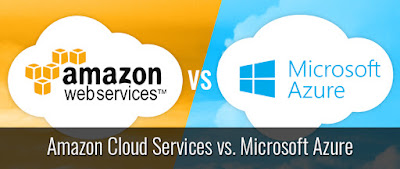In the cyberspace, changes and upgrades are vital and the
degree of adopting current trends as well as the capability to support future
enhancements are the key goals of the cloud service providers. Due to the
presence of Cloud Tech Giants in IT world, competition among them has led to a
battle field of cloud where the vendors are trying to get more public attention
by either dropping the prices or introducing new functionalities on existing
cloud platforms.
In this article, we are going to gain an insight into the comparison
among three cloud giants:-
·
Amazon Web Services (AWS)
·
Google Cloud Platform (GCP)
·
Microsoft’s Azure
To compare these giants, we will focus on the service types
they are offering:-
1. Computing efficiency
2. Storage
3. Networking infrastructure
4. Pricing
Computing efficiency:-
AWS
|
GCP
|
Azure
|
Amazon’s core compute service :AWS’s EC2 (Elastic Compute Cloud)
|
Google’s core compute service: Google
Compute Engine (GCE)
|
Introduced
the compute service as a preview, and made available the service for general
use on May 2013
|
Facilitates users to configure virtual machines using
either pre-configured or custom AMIs (machine images).
|
Allows users launch virtual machines, much like AWS,
into regions and availability groups.
|
Promptstheusers to choose a VHD (Virtual Hard Disk) to
create a Virtual Machine.
|
Supports load balancing (ELB-EC2 Load Balancing) and auto
scaling.
|
Supports load balancing and extended
support for Operating Systems
|
Load
balancing by disk virtualization. User just needs to
specify the number of cores and amount of memory
|
2.Storage:-
AWS
|
GCP
|
Azure
|
Offers ephemeral (temporary) storage which is allocated
once an instance is started.It is destroyed after the termination of the
instance.
|
Provides both temporary storage and persistent disks.
|
Uses temporary storage (D drive) and Page Blobs
(Microsoft’s Block Storage option) for VM-based volumes.
|
Provides Block Storage ( equivalent to hard disks in PCs)
|
Primary storage medium:Google Cloud Storage.GCP supports
relational DBs through Google Cloud SQL
|
Block Blobs and Files are used for Object Storage.
|
Offers object storage with S3 Service and archiving
services with Glacier. Fully supports relational and NoSQL databases and Big
Data.
|
Google Services: Big Query, Big Table, and Hadoop, are
fully supported. Google’s Nearline offers archiving just like the AWS
Glacier, but with virtually no latency on recovery.
|
Supports both relational and NoSQL databases, and Big Data,
through Windows Azure Table and HDInsight.
|
3. Networking Infrastructure:-
AWS
|
GCP
|
Azure
|
Networking
Component: Amazon’s Virtual Private Clouds (VPCs)
|
Networking
Component: Google Compute Engine Subnets
|
Networking
Component: Azure’s Virtual Network (VNET)
|
allow users to group VMs into isolated networks in the
cloud
|
Compute Engine instance belongs to a single network, which
defines the address range and gateway address for all instances connected to
it.
|
allow users to group VMs into isolated networks in the
cloud
|
users can define a network topology, create subnets,
route tables, private IP address ranges, and network gateways.
|
Firewall rules can be applied to an instance, and it can
receive a public IP address.
|
users can define a network topology, create subnets,
route tables, private IP address ranges, and network gateways.
|
Supports Public IP
|
Supports Public IP
|
Supports Public IP
|
Supports Hybrid Cloud
|
No Support for Hybrid Cloud
|
Supports Hybrid Cloud
|
Supports Firewalls
|
Supports Firewalls
|
Supports Firewalls
|
5. Pricing:
AWS
|
GCP
|
Azure
|
Charges customers by rounding up the number of hours used
|
charges for instances by rounding up the number of minutes
used
|
charges customers by rounding up the number of minutes used
for on demand
|
AWS instances can be
purchased using any one of three models:
|
Google
recently announced new sustained-use pricing for compute services that will
offer a simpler and more flexible approach to AWS’s reserved instances.
Sustained-use pricing will discount the on-demand baseline hourly rate
automatically as a particular instance is used for a larger percentage of the
month.
|
Azure
charges customers by rounding up the number of minutes used for on demand.
Azure also offers short-term commitments with discounts.
|
Pricing Model:
On demand, reserved, spot
|
Pricing Model:
On demand – sustained use
|
Pricing Model:
On demand – short term commitments (pre-paid or monthly)
|
Why AWS is
better?
Scalability
|
· High availability of
on-demandstorage, bandwidth, and computational power.
· Pay as per your use.
|
Costs
|
· Works in a way that the
marginal cost of an additional product keeps going down.
· Less cost for adding more
storage and bandwidth to your account
|
No-Commitment
|
· Offers everything with
absolutely no-commitment at all, not even a month.
· All server-backed services
are charged on hourly basis
|
Security
|
· Data centers are staffed
24×7 by trained security guards, and access is authorized strictly on a least
privileged basis
· Multiple geographic
regions and Availability Zones to combat with failure
· Ability to configure
built-in firewall rules
|
Flexibility
|
· Auto scaling to build a
self-managing infrastructure aligned closely to the actual need based on
traffic/resources utilization.
· Amazon Machine Images
(AMIs) enable you to distribute clones
|
Global
Leader
|
·
global presence with 10 regions, 36 availability zones and more than
50 edge locations
|
API
|















0 comments:
Post a Comment